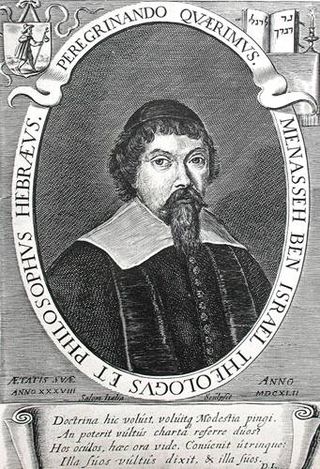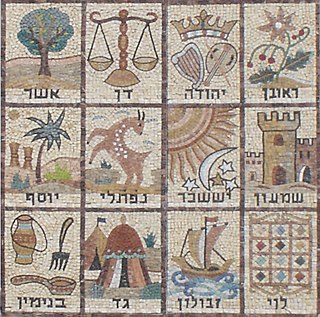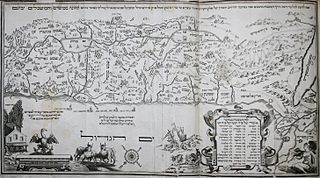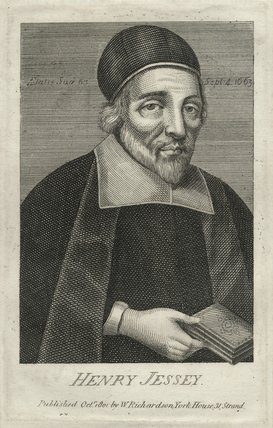Related Research Articles

Judah haLevi was a Sephardic Jewish poet, physician and philosopher. He was born in Al-Andalus, either in Toledo or Tudela, in 1075. He is thought to have died in 1141, in either Jerusalem, at that point the Crusader Kingdom of Jerusalem, or in Alexandria, Egypt.

Manoel Dias Soeiro, better known by his Hebrew name Menasseh or Menashe ben Israel, was a Jewish scholar, rabbi, kabbalist, writer, diplomat, printer, publisher, and founder of the first Hebrew printing press in Amsterdam in 1626.
The History of Sephardic Jews in England consists of the Sephardic Jews' contribution and achievement in England.
The resettlement of the Jews in England was an informal arrangement during the Commonwealth of England in the mid-1650s, which allowed Jews to practice their faith openly. It forms a prominent part of the history of the Jews in England. It happened directly after two events. Firstly a prominent rabbi Menasseh ben Israel came to the country from the Netherlands to make the case for Jewish resettlement, and secondly a Spanish New Christian merchant Antonio Robles requested that he be classified as a Jew rather than Spaniard during the war between England and Spain.

The Jewish Naturalisation Act 1753 was an Act of Parliament which allowed Jews resident in Britain to become naturalised by application to Parliament. It received royal assent on 7 July 1753 but was repealed in 1754 due to widespread opposition to its provisions.
The Bnei Menashe is a community of Indian Jews from various Tibeto-Burmese ethnic groups from the border of India and Burma who claim descent from one of the Lost Tribes of Israel, allegedly based on the Hmar belief in an ancestor named Manmasi. Some of them have adopted Judaism. The community has around 10,000 members.
Spanish and Portuguese Jews, also called Western Sephardim, Iberian Jews, or Peninsular Jews, are a distinctive sub-group of Sephardic Jews who are largely descended from Jews who lived as New Christians in the Iberian Peninsula during the few centuries following the forced expulsion of unconverted Jews from Spain in 1492 and from Portugal in 1497. They should therefore be distinguished both from the descendants of those expelled in 1492 and from the present-day Jewish communities of Spain and Portugal.

The Twelve Tribes of Israel are, according to Hebrew scriptures, the descendants of the biblical patriarch Jacob, who collectively form the Israelite nation. The tribes were through his twelve sons through his wives, Leah and Rachel, and his concubines, Bilhah and Zilpah. In modern scholarship, there is skepticism as to whether there ever were twelve Israelite tribes, with the use of the number 12 thought more likely to signify a symbolic tradition as part of a national founding myth, although some scholars disagree with this view.
The Whitehall Conference was a gathering of prominent English merchants, clergymen, and lawyers convened by Oliver Cromwell for the purpose of debating whether Jews should be readmitted to England. The conference lasted from 4 to 18 December 1655.

The Ten Lost Tribes were those from the Twelve Tribes of Israel that were said to have been exiled from the Kingdom of Israel after it was conquered by the Neo-Assyrian Empire around 720 BCE. They were the following: Reuben, Simeon, Dan, Naphtali, Gad, Asher, Issachar, Zebulun, Manasseh, and Ephraim—all but Judah and Benjamin, both of which were based in the neighbouring Kingdom of Judah and therefore survived until the Babylonian siege of Jerusalem in 587 BCE. Alongside Judah and Benjamin was part of the Tribe of Levi, which was not allowed land tenure, but received dedicated cities. The exile of Israel's population, known as the Assyrian captivity, occurred in line with long-standing Assyrian deportation policy, which was practiced in many subjugated territories.
Saul Levi Morteira or Mortera was a rabbi in Amsterdam. He was born in Venice, so he was neither a Sephardic or Ashkenazic Jew. He became a prominent figure in the city's community of exiled Portuguese Jews. His polemical writings against Catholicism had wide circulation.
John Dury was a Scottish Calvinist minister and an intellectual of the English Civil War period. He made efforts to re-unite the Calvinist and Lutheran wings of Protestantism, hoping to succeed when he moved to Kassel in 1661, but he did not accomplish this. He was also a preacher, pamphleteer, and writer.

Henry Jessey or Jacie was one of many English Dissenters. He was a founding member of the Puritan religious sect, the Jacobites. Jessey was considered a Hebrew and a rabbinical scholar. His active philosemitism has led him to be described as "among Israel's greatest seventeenth-century benefactors."
Nathaniel Holmes or Homes (1599–1678) was an English Independent theologian and preacher. He has been described as a “Puritan writer of great ability".
John Sadler was an English lawyer, academic, Member of Parliament, Town Clerk of London, Hebraist, Neoplatonist and millenarian thinker, private secretary to Oliver Cromwell, and member of the Parliamentarian Council of State. He was Master of Magdalene College, Cambridge from 1650 to 1660.

Petrus Serrarius was a millenarian theologian, writer, and also a wealthy merchant, who established himself in Amsterdam in 1630, and was active there until his death. He was born "into a well-to-do Walloon merchant family by name of Serrurier in London." He has been called "the dean of the dissident Millenarian theologians in Amsterdam".
Abraham Pereyra was a wealthy and prominent Portuguese Jewish merchant, who lived in Amsterdam from circa 1644 to his death in 1699.
Moses Pallache, was a Jewish-Moroccan-born merchant and diplomat of the Pallache family, who emerged as leader of his second generation.
Thomas Thorowgood, B.D., was a Puritan minister and preacher in King's Lynn, Norfolk, England. He was the first English author to argue in 1650 that American Indians were descended from the Lost Ten Tribes of the biblical ancient Israelites. This theory was an early 16th century Christian theory that was revived in popularity during the beginning of the English colonisation of North America in the 17th century.
Jewish Indian theory is the erroneous idea that some or all of the lost tribes of Israel had travelled to the Americas and that all or some of the Indigenous peoples of the Americas are of Israelite descent or were influenced by still-lost Jewish populations. The theory was popular in the late seventeenth century, and had a lasting legacy through its influence on Mormon belief.
References
- Kochan, Lionel (1984). "Review: Philo-Semitism and the Readmission of the Jews to England 1603–1655 by David Katz". English Historical Review . 99 (393): 885. doi:10.1093/ehr/XCIX.CCCXCIII.885-a.
- Méchoulan, Henry; Nahon, Gérard, eds. (1987). Menasseh Ben Israel. The Hope of Israel. Oxford: Oxford University Press. ISBN 0-19-710054-6.
- Wilensky, M. (1951). "The Royalist Position concerning the Readmission of Jews to England". Jewish Quarterly Review . New Ser. 41 (4): 397–409. JSTOR 1453207.